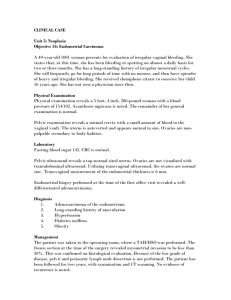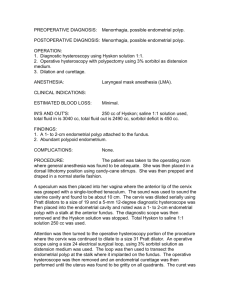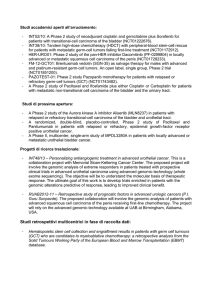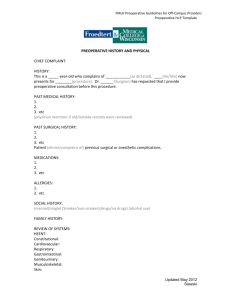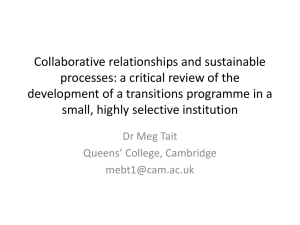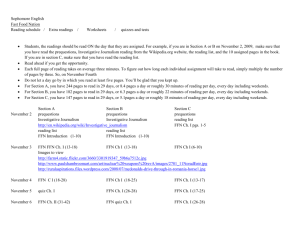gynecology-obstetrics - University at Buffalo, School of Medicine and
advertisement
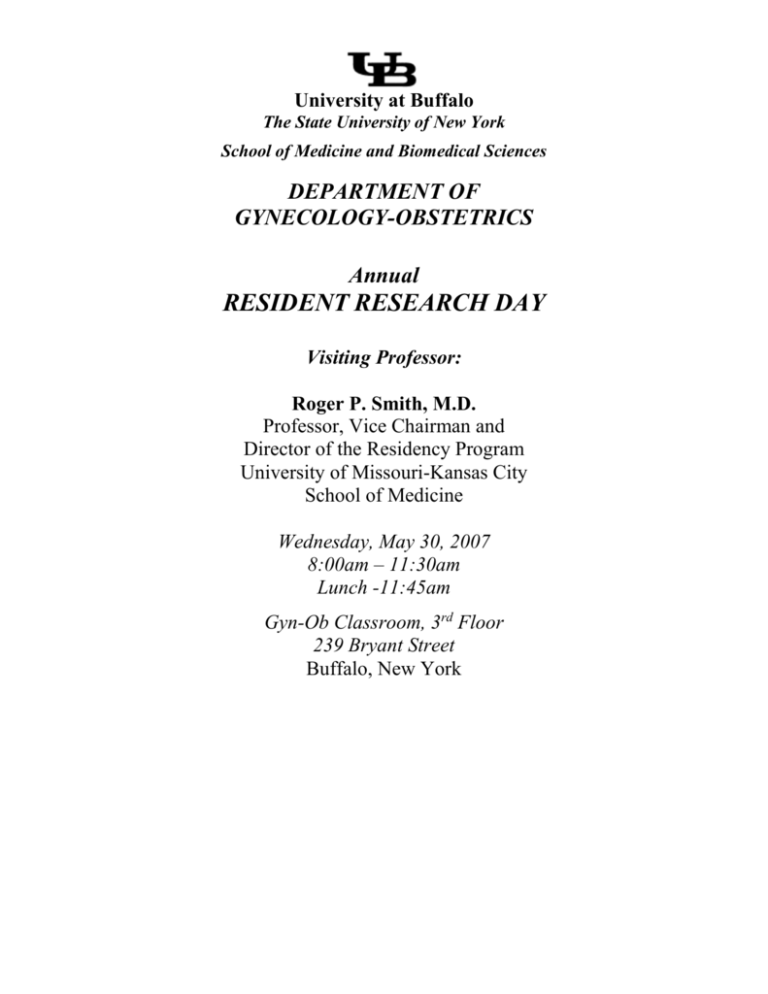
University at Buffalo The State University of New York School of Medicine and Biomedical Sciences DEPARTMENT OF GYNECOLOGY-OBSTETRICS Annual RESIDENT RESEARCH DAY Visiting Professor: Roger P. Smith, M.D. Professor, Vice Chairman and Director of the Residency Program University of Missouri-Kansas City School of Medicine Wednesday, May 30, 2007 8:00am – 11:30am Lunch -11:45am Gyn-Ob Classroom, 3rd Floor 239 Bryant Street Buffalo, New York Resident Research Day Schedule Wednesday, May 30, 2007 Moderator: Glenna Bett, Ph.D. 8:00 – 8:10 a.m. “Can Preoperative EMB/D&C Predict Final Pathology Results in Patients with Endometrial Carcinoma” Irene Tan, M.D. Mentors: Shashikant Lele, M.D. & Pankaj Singhal, M.D., M.S. 8:15 – 8:25 a.m. “Bowel obstruction among patients with recurrent epithelial ovarian cancer” Dariush Tonkaboni, M.D. Mentors: Shashikant Lele, M.D. & Pankaj Singhal, M.D., M.S. 8:30 – 8:40 a.m. “Prognostic factors and patterns of outcomes and failures in early stage and late stage clear cell carcinoma of the endometrium” Dennis Mauricio, M.D. Mentors: Shashikant Lele, M.D. & Pankaj Singhal, M.D., M.S. 8:45 – 8:55 a.m. “Efficacy of a Gemcitabine Based Multiagent Chemotherapy Regimen for Advanced Uterine Sarcomas” Maria Benitez, M.D. Mentors: Shashikant Lele, M.D. & Pankaj Singhal, M.D., M.S. 9:00 – 9:10 a.m. “Use of Fetal Fibronectin Test in Preterm Labor Evaluation in a Community Hospital” Kavitha Raj, M.D. Mentor: Michael Ray, M.D. 9:15 – 9:25 a.m. “A Review of the Etiology of Fetal Losses and Coxsackie Placental Infection in a Community Hospital” Cynthia Mangubat, M.D. Mentors: Donald Schmidt, M.D. & Chad Strittmatter, M.D. 9:30 – 9:45 a.m. BREAK Moderator: Armando Arroyo, M.D. 9:45 – 9:55 a.m. “Syncytial Trophoblastic Knots (Tenney-Parker Changes) In The Placenta And Newborn Hypoxia And Complications Of Pregnancy, Is There A Connection?” Ibrahim Joulak, M.D. Mentors: John Fisher, M.D., Lani Burkman, Ph.D., James Shelton, B.A. & Glenna Bett, Ph.D. 10:00 – 10:10 a.m. "Decreased Meternal Serum Inhibin-A in pregestational Diabetic Women; Implication for Adjustment." Nezhat Solimani, M.D. Mentors: Bruce Rodgers M.D., John Yeh M.D. & Abeer Eddib M.D. 10:15 – 10:25 a.m. “Re-evaluating Screening Guidelines for Gestational Diabetes in Twin Gestation Pregnancies" Elve Laborde, M.D. Mentors: Kofi Amankwah, M.D. & Lani Burkman, Ph.D. 10:30 – 10:40 a.m. “Incidence of concurrent complex endometrial hyperplasia with atypia and endometrial cancer” Jenny Lee, M.D. Mentor: Abeer Eddib, M.D. 10:45 – 10:55 a.m. “Intramyometrial Injection of Vasopressin in Laparoscopic Supracervical Hysterectomy” Fadi Makhlouf, M.D. Mentors: Ali Ghomi, M.D. & Seshadri Kasturi, M.D. 11:00 – 11:30am “Burnout” Roger P. Smith, M.D. Professor, Vice Chairman and Director of the Residency Program University of Missouri-Kansas City School of Medicine 11:45 a.m. Presentation of Research Awards By Dr. Roger P. Smith 11:45 a.m. Lunch in Gyn-Ob Library / Classroom ABSTRACTS “Can Preoperative EMB/D&C Predict Final Pathology Results in Patients with Endometrial Carcinoma” Irene Tan, M.D. Mentors: Shashikant Lele, M.D. & Pankaj Singhal, M.D., M.S. Objectives: 1) To correlate preoperative endometrial biopsy EMB/D&C results with final histology in surgically staged endometrial carcinoma patients. 2) To study the surgical stage, grade, histology, myometrial invasion, lymphovascular space invasion, nodal metastasis, and impact on treatment in patients who were found to have Grade 1 endometrial carcinoma on EMB/D&C and were upgraded on final pathology results. Methods: Between June 2003 and January 2005, data from all patients with endometrial cancer who underwent surgical staging for endometrial carcinoma were evaluated. This group included 119 patients who had preoperative EMB/D&C results available. All EMB/D&C pathology slides were reviewed by a gynecologic pathologist at our institution. Patient demographics, clinical information, surgical, chemotherapy and radiation treatment information were collected. Results: Eighty nine out of 119 (75%) of the patients were reported as endometrioid carcinoma on preoperative EMB/D&C. Final postoperative histology results were in agreement in 63% of these patients. The remainder of the cases were reported as UPSC (12%), carcinosarcoma (13%), clear cell (3%) and mixed (9%) histologies. Grade1 (G1) was reported in 47 (of 89) patients on EMB/D&C. On final pathology, 17 of these 47 (36%) cases were upgraded to Grade 2 (G2; n=15) or Grade3 (G3; n=2). Among patients that were upgraded to G2 and G3, 15 patients had <50% myometrial invasion. However, 7 patients (15%) were upstaged by virtue of cervical involvement (n=2), adenxal involvement (n=2), pelvic lymph node metastasis (n=2), or para-aortic lymph node metastasis (n=1). Conclusions: Several studies have reported a low incidence of nodal metastasis in women who had a preoperative EMB/D&C specimen showing G1, well differentiated endometrioid carcinoma. Our study shows a discordance rate of 37% between preoperative EMB/D&C endometriod histology and the final histology report. The discordance is clinically significant since the final histology is G3, thus requiring staging information for proper adjuvant treatment. When considering EMB/D&C reported G1 carcinomas only, 36% of the cases were upgraded. Additionally 15% of these G1 tumors were upstaged, requiring a change in adjuvant therapy or need for staging information. Based on these results, EMB/D&C results showing G1 tumor endometroid cancer should undergo compete surgical staging. “Bowel obstruction among patients with recurrent epithelial ovarian cancer” Dariush Tonkaboni, M.D. Mentors: Shashikant Lele, M.D. & Pankaj Singhal, M.D., M.S. Objective: To evaluate the incidence of late bowel obstruction with epithelial ovarian cancer. Material and Methods: This is a retrospective study of patients with bowel obstruction after undergoing staging laparotomy for advanced epithelial ovarian cancer. All patients with epithelial ovarian cancer were identified within the database (2002 to 2006) from a large gynecology-oncology center. The data collected were analyzed to calculate the incidence of bowel obstruction for these patients, as well as other possible risk factors which could predispose to bowel obstruction (original histological type, staging, etc.). Results: Out of 107 patients who underwent staging laparatomy and chemotherapy for ovarian cancer, 11 patients were diagnosed with bowel obstruction (10.3%). Among these patients 9 out of 11 (81%) were initially diagnosed with stage IIIc and 2 out of 11 (19 %) were initially diagnosed with Stage IV at the time of the original staging laparatomy. Pathologic diagnosis showed that originally 8 out of the 11 patients (73%) had ovarian cancer as the primary, but 27% had primary peritoneal carcinomas. Eight out of 11(73%) showed papillary serous carcinoma and 1 case showed mucinous; 1 was endometriod and 1 revealed carcinosarcoma. The chemotherapy regimens were taxan and a cisplatin-based standard chemotherapy. The average hospital stay for the initial surgery was 8.14 days. There was no significant difference between the patient groups which did or did not have bowel obstruction, relative to their histology (P < 0.05) or origin of the carcinoma (P = 0.83). Conclusions: The results of this retrospective study suggest that late bowel obstruction is common with Epithelial Ovarian Cancer: the incidence is 10.3% for this small study. Parameters such as Histology and amount of residual tumor post surgery showed no significant relationship to the occurrence of late bowel obstruction. “Prognostic factors and patterns of outcomes and failures in early stage and late stage clear cell carcinoma of the endometrium” Dennis Mauricio, M.D. Mentors: Shashikant Lele, M.D. & Pankaj Singhal, M.D., M.S. Objectives: - To determine the prognostic factors in clear cell carcinoma of the endometrium - To compare overall survival and overall recurrence in early stage and late stage clear cell carcinoma of the endometrium - To determine the outcome of the different treatments in early stage and late stage clear cell carcinoma of the endometrium Methods: Clinical and surgicopathologic data were retrospectively collected on 44 patients with histopathologic diagnosis of clear cell carcinoma of the endometrium at Roswell Park Cancer Institute (1971 to 2006). FIGO staging was assigned. The cases were then divided into early stage disease and late stage disease, and treatment modalities were described. Overall survival and overall recurrence rates were determined using Kaplan-Meier. For both early stage and late stage groups, correlation of survival and recurrence with disease stage, grade, depth of invasion, tumor size, cytology, lymphovascular involvement, cervical involvement, extrauterine involvement, and nodal status were computed. Results: Among the 44 cases in the study, 52.3% represent early stage cancer: stage I (40.9%) and stage II (11.4%). The remainder (47.7%) showed late stage disease: stage III (27.3%) and stage IV (20.4%). The overall survival rate was 4.75 years and mean disease-free survival was 3 years. For early stage disease, a patient with stage Ib carcinoma had an overall survival of 8 years, and the longest recurrence interval with 7 years. These patients received both surgery and post-operative radiotherapy. For late stage disease, the longest survival interval was 2 years (stage IIIb) and the shortest survival interval was only one month (stage IVb). Recurrence in late stage disease was documented as early as two months (stage IVb) and the latest was 20 months (stage IIIb). For early stage disease, surgery and radiotherapy together appear to prolong survival, but does not seem to affect recurrence. For late stage carcinoma, there seems to be no difference between surgery plus chemotherapy, or surgery with radiotherapy, for survival and recurrence. The addition of neoadjuvant radiotherapy to surgical treatment seems to improve survival and recurrence rates. Aside from disease stage, cancer grade, depth of invasion, size, cytology, lymphovascular, cervical and nodal involvements do not correlate with survival or recurrence rate. Conclusion: Clear cell carcinoma of the endometrium is a very rare disease with no known optimal treatment. Tumor stage seems to correlate with survival and disease recurrence. For early stage carcinoma, surgery plus radiotherapy seem to favor survival but does not effect recurrence. In late stage disease, there is no difference between surgery plus radiotherapy versus surgery plus chemotherapy on patient survival or disease recurrence. Future protocols should focus on locoregional radiotherapy as an adjunct to surgery. “Efficacy of a Gemcitabine Based Multiagent Chemotherapy Regimen for Advanced Uterine Sarcomas” Maria Benitez, M.D. Mentors: Shashikant Lele, M.D. & Pankaj Singhal, M.D., M.S. Background: Advanced stage uterine sarcomas (US) have a poor prognosis. Active agents in US are doxorubicin, cisplatin and ifosfamide, with response rates (RR) of 25%, 19%, and 17%, respectively. Given the poor response, there remains a need for other drug options. Gemcitabine has shown activity in soft tissue sarcomas. In trials with all subtypes of sarcomas, RR observed with single or multiagent schedules range from 3 to 53%. There is scant data for the use of gemcitabine in US cases. The aim of our study was to determine the clinical activity of a gemcitabine-based regimen using patients with uterine sarcoma. Methods: We reviewed data from 11 chemotherapy-naïve patients who were diagnosed with advanced stage US (2002-2005). The patients received the GIP combination chemotherapy (gemcitabine/ifosfomide/platinum) in an adjuvant setting, after TAH and surgical staging. This regimen consisted of Ifosfomide 2gm/m 2 and Platinum 20 mg/m2 intravenously on days 1, 2 and 3. Gemcitabine 800 mg/m 2 was then administered intravenously on day 1 of a 28-day cycle. Results: Eleven patients were treated, all with stage III and IV cancer. The median age was 49 years. There were 6 carcinosarcomas, 4 LMS, and 1 ESS. The performance status was 0 for six patients, and 1 for the other 5 patients. Four patients (36%) had undergone prior radiotherapy. The site of measurable disease in 10 patients (91%) was in the pelvis. The median number of GIP cycles received per patient was 6 (range 1-9). There were no treatment-related deaths. Hematologic toxicities of > Grade 3 were seen in 82% of the cases, consisting of leukopenia and anemia. Febrile neutropenia occurred for 36% of the patients. Neurotoxicity (Grade 3, n=2), nausea (Grade 1 or 2, n=6), and fatigue (Grade 1 or 2, n = 7) were observed. Three (27%) complete responses were observed and four subjects had a partial response (36%), giving an overall RR of 63%. Four patients had progression of disease (36%). Of the 7 patients demonstrating a response, 4 had previously been irradiated and 3 had not. The RR in those previously irradiated was 4/4 = 100% versus 3/7 = 43% in those not previously irradiated. Conclusions: The combination of GIP is well-tolerated and seems to be active in cases with uterine sarcoma, yielding RR higher than seen with single agent chemotherapy regimens. Patients that received previous adjuvant radiation demonstrated the best responses. A randomized trial is needed to evaluate the true value of this regimen in advanced stage US. “Use of Fetal Fibronectin Test in Preterm Labor Evaluation in a Community Hospital” Kavitha Raj, M.D. Mentor: Michael Ray, M.D. Objective: To assess the efficacy of biochemical marker fetal fibronectin (FFN) in predicting preterm delivery, its negative predictive value, impact on hospital admissions, length of hospital stay, impact on interventions. Hypothesis: Fetal fibronectin is helpful in identifying patients not at risk of preterm delivery, thus helpful to avoid hospital admission, prolonged hospital stay & unnecessary interventions. Methodology: Patients who underwent cervicovaginal fetal fibronectin test at Sisters hospital labor and delivery unit from June 2005 – June 2006 charts were analyzed. FFN test is performed by immunochromatographic assay. Results of the test were notified as either “Positive” or “Negative”. Gestational age at FFN test, gestational age at delivery, hospital parity, Preterm contractions at least six per hour & Intact membranes. Exclusion criteria include multiple gestations, vaginal bleeding, pelvic exam or sexual intercourse in the preceding 24 hours, ruptured membranes, cervical dilation of more than 3 cm, and cervical length by transvaginal ultrasound less than 25 mm, cervical cerclage. Results: Two hundred ninety five charts were reviewed.270/295 (91 %) tested negative; 25/295 (9 %) tested positive. Of those with negative FFN, none delivered <14 days of the test & <34 weeks gestation with mean gestational age of 39 + 1.2 wks at delivery; with 16 % hospital admission, mean hospital stay of 21/7 + 3.9d; and 16 % intervention (Tocolysis and Betamethasone). Of those who tested positive FFN, 8 % delivered < 7 days of the test & 16 % delivered <34 weeks gestation with mean gestational age at delivery 37 1/5 +3.3wks; 72 % got admitted, with mean hospital stay of 5.5 + 3.6 days; interventions; tocolysis 72 %; betamethasone 84% Negative predictive value /NPV was noted to be 100 % for delivery <7 days, >14 days of the test & >34 weeks. Positive predictive value/PPV noted to be 8% (2/25) for delivery < 2 weeks of the test; 92 % (23/25) for delivery >14 days of the test & 16 % (4/25) for delivery < 34 weeks. Hospital admission, length of hospital stay, interventions was significantly lower for FFN negative group. Conclusion: Use of FFN was helpful in identifying patients not at risk for preterm delivery, in reducing hospital admission, length of hospital stay & interventions. Consider clinical assessment such as cervical length, cervical dilation, infectious etiology, preterm contractions, previous history of preterm labor in patients with positive FFN test to avoid unnecessary interventions & hospital admissions since the PPV of the test is much lower when compared to NPV. “A Review of the Etiology of Fetal Losses and Coxsackie Placental Infection in a Community Hospital” Cynthia Mangubat, M.D. Mentors: Donald Schmidt, M.D. & Chad Strittmatter, M.D. Objective: To review the etiology and to determine the incidence of viral placental infections in antepartum and intrapartum fetal deaths at 20 weeks gestation or more in a community hospital. Methods: A retrospective chart review of 44 cases of perinatal losses at >/=20 weeks gestation reported from the Sisters of Charity Hospital Buffalo NY annual statistics within a two year period (January 2004 to December 2005) were studied. Patient demographics, perinatal outcome, laboratory work-up, regular pathology reports were collected. Paraffin slides of the placenta were sent for viral studies: PCR for specific viral DNA/RNA primers and immunohistochemical staining for viral antigens and nucleic acids. Results: Forty-four pregnancies (including 5 sets of twins) with mothers at mean age 28.8 + 8 years with mean gravidity of 3.4 + 2.4 and parity 1.2 + 1.5 resulted in 29 antepartal and 15 intrapartal deaths at mean gestational age of 28.7 + 6.9 weeks and mean birthweight of 1237 + 1201 grams. Prior to viral placental studies, the following etiology of fetal demise were noted: fetal anomaly 2/44, 5%; HTN/DM 7/44, 16%; PPROM/ incompetent cervix 5/44, 11%; dystocia 1/44, 2%; infectious/chorioamnionitis 6/44, 14%, abruption 7/44, 16%, FGR/placental insufficiency 4/44, 9%; cord accident 1/44, 2%; twin-to-twin-transfusion syndrome 2/44, 4%; unknown 8/44, 18%. Only 20 of the 46 placentas were available for viral studies which elucidated 7/20 cases of coxsackie infection which were previously categorized as non-infectious, increasing the infectious etiology to 13/44 (30%); reducing the unknown etiology to 6/44 (14%) Conclusion: Thus, viral placental studies are helpful in determining the cause of fetal losses especially where etiology is unknown and in potential medicolegal cases. Since not all the placentas had viral studies done, we were unable to determine the incidence of viral placental infections in fetal demise. “Syncytial Trophoblastic Knots (Tenney-Parker Changes) In The Placenta And Newborn Hypoxia And Complications Of Pregnancy, Is There A Connection?” Ibrahim Joulak, M.D. Mentors: John Fisher, M.D., Lani Burkman, Ph.D., James Shelton, B.A. & Glenna Bett, Ph.D. Objective: Since 1940 there has been controversy concerning whether placental pathology correlates with fetal and delivery outcomes. Is there a correlation between the presence of syncytial trophoblastic knots (TenneyParker) in the placenta and newborn hypoxia or maternal complications? Methods: This is a retrospective, case-controlled study including 104 women with histologically confirmed syncytial trophoblastic knots (KNOT) and 104 randomly selected controls (CONTROL). All cases (n = 208) were obtained from Women’s and Children’s Hospital of Buffalo. IRB approval was obtained. The database included 19 parameters related to maternal demographics, pregnancy complications, delivery outcome, fetal status, and cord blood gas parameters. Statistical analysis (t-test, chi-squared) was performed comparing these two groups. Results: We have demonstrated that there was a significant increase in complications of pregnancy when knots were detected in placental tissue evaluated in the pathology laboratory. The group with KNOTs showed a doubling of the incidence for pre-term labor (19.2% vs. 9.6%, P = 0.05) when compared to the Control cases. Again, the presence of KNOTs was associated with a 75% increase in the rate of C-Section (47.1% vs 26.9%, P = 0.003). Significant increases were also present for: pre-eclampsia (P = 0.017), IUGR (P=0.031), diabetes (P=0.031), meconium at delivery (P=0.014), reduced cord blood pH (P = 0.037). KNOTs were linked to decreased newborn weight (P = 0.039). Conclusions: These findings contribute to the current hypothesis that syncytial knots may be a significant factor in multiple complications of pregnancy outcome and newborn status. "Decreased Meternal Serum Inhibin-A in pregestational Diabetic Women; Implication for Adjustment." Nezhat Solimani, M.D. Mentors: Bruce Rodgers M.D., John Yeh M.D. & Abeer Eddib M.D. Objective: To evaluate the effect of maternal pregestational diabetes on dimeric inhibin-A (DIA), one of the four serum markers comprising the quadruple screen (QS). Methods: The data were collected retrospectively from women with singleton pregnancies who had QS drawn at 15 to 20 weeks of gestation in 2004 to 2006. A total of 84 women with pregestational diabetes were identified and their DIA values were compared with 100 non-diabetic pregnant women. The DIA in QS is expressed as Multiples of Median (MoM). We compared the median MoM for DIA levels among Diabetics, nondiabetics, and among the two types of Diabetics. We also attempted to see if there was a correlation between the QS markers and glycosylated hemoglobin (HbA1C). Statistical analysis was performed using Mann-Whitney test. Results: The median MoM for DIA levels among diabetic patients was 0.94 (95% CI: 0.79-1.12) versus 1.09 (95% CI: 0.99-1.21) in the non-diabetic control group (p value = 0.001). The median MoM for DIA levels did not appear to differ between the two types of diabetes. There does not appear to be a correlation between the QS markers and glycosylated hemoglobin (HbA1C). Conclusion: There is a significant decrease in DIA levels among pregestational diabetic women. This result suggests consideration for adjustment with a correction factor, so that the QS can be used in diabetic pregnancies with the same sensitivity and predictive value as non-diabetic pregnancies. “Re-evaluating Screening Guidelines for Gestational Diabetes in Twin Gestation Pregnancies” Elve Laborde, M.D. Mentors: Kofi Amankwah, M.D. & Lani Burkman, Ph.D. Objective: The traditional literature states that 3-6 % of twin gestation pregnancies will have gestational diabetes. A one-hour glucose challenge test (GCT) is a key diagnostic procedure. However, the standard cut-off value (> 140 mg/dL) is derived from studies with singleton pregnancies. We hypothesized that the current screening guidelines, when applied to the diagnosis of gestational diabetes in twin pregnancies, will overestimate the incidence of diabetes. Methods: We have begun to review all twin gestations delivered at Women and Children’s Hospital in Buffalo, NY, during the period from January 1, 2002, to December, 2006. In a preliminary study, we have analyzed maternal demographics, results from the 1-hr 50g glucose challenge test (GCT), gestational age at birth, and neonatal birth weights. Women who delivered prior to 24 weeks of gestation, or had pre-existing diabetes were excluded from the database. Results: Three hundred twin gestation delivery records were located. This preliminary assessment included 57 random cases out of the total group. Analysis is continuing on the remaining cases. Eight of the 57 (14%) had 1hr GCT values which exceeded the standard cut-off of 140 mg/dL. One-fourth of these were later confirmed to have gestational diabetes using standard criteria. The 57 cases provided data on 109 neonates. Birthweights from the High GCT group (n = 8) were compared with birthweights from babies in the Normal GCT group, according to gestational age groupings. Each gestational age sub-group showed that birthweights for the High GCT group exceeded birthweights from the Normal GCT group. The High GCT babies were 3-9% larger. The initial data set is still too small to show a significant difference between mean birthweight for the two groups (2090 g 73 versus 2301 g 172; P = 0.13) or mean BMI for the two groups (33.9 versus 36.4; P = 0.24). Complete assessment of the 300 cases may convert the several trends to significance. Conclusion: In this preliminary assessment, the one-hour GCT data, using the standard cut-off of 140, indicated that 14% of the twin gestations may be at some risk for gestational diabetes. The High GCT cases show a trend towards elevated BMI in the mother, as well as higher birthweight in the newborn. The completed data can be re-assessed using alternate GCT cut-off values, and re-evaluation of the standard GDM guidelines. “Incidence of concurrent complex endometrial hyperplasia with atypia and endometrial cancer” Jenny Lee, M.D. Mentor: Abeer Eddib, M.D. Objective: To determine the concurrent incidence of endometrial hyperplasia and endometrial cancer in cases from the Kaleida Health Care system (1999-2006) and to determine the parameters for oncology support. Methods: This IRB approved study reviewed the records for all women who underwent hysterectomy for a preoperative diagnosis of complex endometrial hyperplasia with atypia. Records were obtained from the Kaleida system for 1999-2006. Individual parameters such as age, race, BMI, gravida and parity, social history, exposure to tamoxifen and method of preoperative diagnosis were recorded and analyzed to determine the propensity for concurrent endometrial cancer, as well as the necessity for oncology assistance. Results: A total of 266 patients were found to have a preoperative diagnosis of endometrial hyperplasia. However, upon review of the pathology, only 66 patients had a preoperative diagnosis of complex endometrial hyperplasia with atypia (CAH). The average age for these patients was 53.8 (range 34-77 years of age) with a majority of the patients being Caucasian (91%). Preoperative diagnosis was made via samples from endometrial biopsies in 32 of the patients, while 34 patients were diagnosed via D&C. The type of hysterectomy varied: 57% had total abdominal hysterectomy (TAH; n=38), 32% as laparascopic assisted vaginal hysterectomy (LAVH; n=21), and 11% with total vaginal hysterectomy (TVH; n=7). Approximately 46% retained the preoperative diagnosis of CAH; 37% received a downgraded post operative diagnosis; 15% were normal; 17% were simple hyperplasia with atypia, and 5% were complex hyperplasia without atypia. However, 17% were, upgraded to cancer (n=11) with staging limited to 1B or less. Conclusion: The rate of concurrent CAH and cancer in our study was 17%. There was no individual parameter that increased the propensity for oncology assistance. The type of surgery also did not affect the final diagnosis or the need for surgical staging. “Intramyometrial Injection of Vasopressin in Laparoscopic Supracervical Hysterectomy” Fadi Makhlouf, M.D. Mentors: Ali Ghomi, M.D. & Seshadri Kasturi, M.D. Objective: To investigate the effectiveness of vasopressin to reduce blood loss in laparoscopic supracervical hysterectomy. Design: Retrospective chart analysis (Canadian Task Force classification II-2). Setting: University-affiliated teaching hospital. Patients: 143 women who had LSH for benign gynecologic disease. Interventions: Laparoscopic supracervical hysterectomy (LSH). Measurements and Main Results: Between January 2001 and December 2006, 143 patients were identified whom had successful LSH performed by different gynecologic laparoscopists. There were no exclusion criteria. The subjects were divided into two groups based on whether intramyometrial vasopressin injection was used intraoperatively to reduce blood loss, 77 (54%) patients received intramyometrial vasopressin injection and 66 (46%) did not. The two groups were compared with regard to blood loss, operating time, uterine weight, hospital stay, concomitant oophorectomy, peri-operative complications, and patient characteristics including age, gravity, parity, body mass index, past surgical history, and the number of cesarean deliveries. There was no difference in the first post-operative day drop in hemoglobin between vasopressin and control group, 2.28 ± 0.92 vs. 2.17 ± 1.2 gm/dl respectively (p = 0.56). There was no significant difference between the groups with respect to operating time (147 ± 53 vs.132 ± 43 min, p = 0.06) and uterine weight (145 ± 122 vs. 119 ± 67 gm, p = 0.13). All other parameters and patient characteristics were similar between the two groups except for the duration of hospital stay. Patients who received intramyometrial vasopressin injection experienced a longer duration of hospital stay (1.36 ± 0.68 vs. 1.13 ± 0.39 days, p = 0.02). Conclusions: Our study does not support the routine use of intramyometrial vasopressin injection during LSH in order to reduce blood loss.
